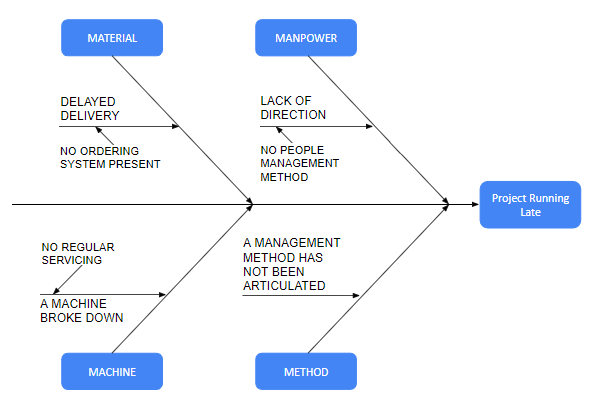
There are only a few easy steps involved in creating this diagram.

It works particularly well for solving difficult issues. It was developed by Japanese professor Kaoru Ishikawa and is also referred to as a cause-and-effect or fishbone diagram. In other words, they may end up solving the wrong problem.An excellent tool for locating the causes of issues is the Ishikawa diagram. Without such a visual analysis, a team may waste time brainstorming solutions to what they assume is the problem, when in fact it may only be a symptom. Conclusionīy exploiting the combined knowledge and experience of a group of people, the Ishikawa diagram helps identify cause and effect relationships in problems. The training of the personnel shows up under manpower (ineffectively trained) and procedure (not followed). The most likely causes will have the most dots. Ask each team member to place three tally marks or colored sticky dots on the fishbone next to what they believe are the root causes that could potentially be addressed.
Or consider a multi-voting technique such as having each team member identify the top three root causes. To determine the ones most likely responsible for the problem: Identify Root Causes: There are usually many contributors to a problem, so an effective fishbone diagram should have many potential causes listed in categories and sub-categories. Keep asking “Why?” and generate deeper levels of causes and continue organizing them under related causes.įor the cause “Ineffectively trained”, a sub-cause can be: proficiency not demonstrated. Write sub-causes branching off the cause categories. Add root sub-causes (determine deeper causes): Again ask “Why does this happen?” about each cause. In the example above for the category “Manpower”, one possible root cause is: Ineffectively trained. Causes can be written in several places if they relate to several categories. Ask “Why does this happen?” As each idea is given, the facilitator writes the causal factor as a branch from the appropriate category. Add root causes: Brainstorm all the possible causes of the problem. Measurement/Medium: including weather, terrain, obstructions, lighting. Manpower (people): causes are in humans, people. Material: causes are in defect or material properties. Method (process): causes are in the rules, regulations, laws or standards. Machine (equipment): causes are in equipment, such as machinery, computers, tools, instruments, technology. Agree on the major categories of the problem causes: The major categories are written as branches from the main arrow. In the example above the problem is a product contamination. 

Make sure that all the members of the brainstorming understand it and have the same interpretation of the problem definition.
 Agree on the problem statement (the effect): The problem definition is written at the mouth of the “fish.” Be as clear and specific as you can about the problem. Define one facilitator, who will be in charge of collecting the ideas for the fishbone completion. Create your team: Include team members who know the processes and systems involved in the problem or event investigated. The left side of the diagram or “the bones of the fish” is where the possible contributing causes/factors are listed.Ī cause and effect diagram can be created in six steps: The effect is written as the problem statement for which you are trying to identify the causes. The right side of the diagram or “the head of the fish” lists the effect/the problem.
Agree on the problem statement (the effect): The problem definition is written at the mouth of the “fish.” Be as clear and specific as you can about the problem. Define one facilitator, who will be in charge of collecting the ideas for the fishbone completion. Create your team: Include team members who know the processes and systems involved in the problem or event investigated. The left side of the diagram or “the bones of the fish” is where the possible contributing causes/factors are listed.Ī cause and effect diagram can be created in six steps: The effect is written as the problem statement for which you are trying to identify the causes. The right side of the diagram or “the head of the fish” lists the effect/the problem.








 0 kommentar(er)
0 kommentar(er)
